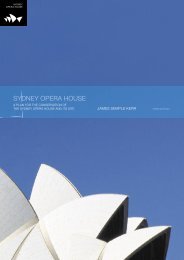Annual Report 2011 - Sydney Opera House
Annual Report 2011 - Sydney Opera House
Annual Report 2011 - Sydney Opera House
Create successful ePaper yourself
Turn your PDF publications into a flip-book with our unique Google optimized e-Paper software.
78SYDNEY OPERA HOUSE TRUSTnotes TO AND FORMING PART OF THE FINANCIAL STATEMENTSthe present condition of the assets), thegross amount and the related accumulateddepreciation are separately restated.For other assets, any balances ofaccumulated depreciation at therevaluation date in respect of those assetsare credited to the asset accounts towhich they relate. The net asset accountsare then increased or decreased by therevaluation increments or decrements.Revaluation increments are crediteddirectly to the asset revaluationreserve, except that, to the extent thatan increment reverses a revaluationdecrement in respect of that class ofasset previously recognised as an expensein the surplus/deficit, the increment isrecognised immediately as Income in thesurplus/deficit.Revaluation decrements are recognisedimmediately as expenses in the surplus,except that, to the extent that a creditbalance exists in the asset revaluationreserve in respect of the same class ofassets, they are debited directly to theasset revaluation reserve.As a not-for-profit entity, revaluationincrements and decrements are offsetagainst one another within a class ofnon-current assets, but not otherwise.Where an asset that has previously beenrevalued is disposed of, any balanceremaining in the asset revaluation reservein respect of that asset is transferred toaccumulated funds.(iv) Impairment of Property, Plant & EquipmentAs a transitional entity, reportingunder the not-for-profit guidelines, theimpairment testing requirements aremodified under AASB 136. AASB 136modifies the recoverable amount test tothe higher of fair value less costs to selland depreciated replacement cost. Thismeans that, for an asset already measuredat fair value, impairment can only ariseif selling costs are material. Selling costsare deemed immaterial.(v) Intangible AssetsThe intangible assets held by <strong>Sydney</strong><strong>Opera</strong> <strong>House</strong> Trust comprise software forinternal use and is recognised at cost.Intangible assets are subsequentlymeasured at fair value only if there isan active market. As there is no activemarket for the agency’s intangible assets,the assets are carried at cost less anyaccumulated amortisation.The useful lives of intangible assets areassessed to be finite. The Trust’s softwareis amortised on a straight line basis over3-5 years.All intangible assets were assessed forimpairment as at 30 June <strong>2011</strong>. Nointangible assets were found to be impaired.(vi) Depreciation and AmortisationDepreciation is provided on certainproperty, plant and equipment.Depreciation is calculated on a straightline basis so as to write off the depreciableamount of each asset over its expecteduseful life to its estimated residual value.Leasehold improvements are depreciatedover the period of the lease or estimateduseful life, whichever is the shorter,using the straight line method. Theestimated useful lives, residual values anddepreciation method are reviewed at theend of each annual reporting period.All material separately identifiablecomponents of assets are depreciated overtheir shorter useful lives.Land is not a depreciable asset. The <strong>Sydney</strong><strong>Opera</strong> <strong>House</strong> building and the artworkcollection are considered to be heritageassets with an extremely long useful life.Depreciation for these items cannot bereliably measured because the useful lifeand the net amount to be recovered at theend of the useful life cannot be reliablymeasured. In these cases depreciationis not recognised. The decision not torecognise depreciation for these assets isreviewed annually. In FY11 Managementis of the opinion that depreciation shouldnot be recognised on these assets.Depreciation rates are shown hereunder:Category ofAssetsRate ofDepreciation %Computer hardware 10, 20 & 33.3Computer software 20 & 33.3Plant and equipment Range between1 & 33.3Forklifts and Vehicle 10Grand Organ 0.5Amortisation10, 20 & 33.3of leaseholdimprovements(vii) MaintenanceThe costs of day-to-day servicing ormaintenance are charged as expensesas incurred, except where they relate tothe replacement of a part or componentof an asset, in which case the costs arecapitalised and depreciated.(viii) Leased AssetsA distinction is made between financeleases which effectively transfer from thelessor to the lessee substantially all therisks and benefits incidental to ownershipof the leased assets, and operating leasesunder which the lessor effectively retainsall such risks and benefits.The Trust has no finance leases.<strong>Opera</strong>ting lease payments are charged tothe Income Statement in the periods inwhich they are incurred.The cost of improvement to or onleasehold property is capitalised anddisclosed as leasehold improvements andamortised over the unexpired period ofthe lease term.Leasehold decommissioning costs havebeen capitalised and expensed wherethe <strong>Sydney</strong> <strong>Opera</strong> <strong>House</strong> Trust iscontractually bound to restore the leasedpremises upon lease expiry. The assetand provision for decommissioning costsrepresents the present value of the Trust’sbest estimate of the future sacrifice ofeconomic benefits that will be requiredto restore the leased premises to theiroriginal condition. The estimate hasbeen made on the basis of market valueon commercially leased property. Theunexpired terms of the premises leaserange from 1 to 3 years.(ix) Loans and ReceivablesLoans and receivables are nonderivativefinancial assets with fixedor determinable payments that arenot quoted in an active market. Thesefinancial assets are recognised initiallyat fair value, usually based on thetransaction cost or face value. Subsequentmeasurement is at amortised cost usingthe effective interest method, lessan allowance for any impairment ofreceivables. Any changes are accountedfor in the operating statement whenimpaired, derecognised or through theamortisation process.Short-term receivables with no statedinterest rate are measured at the originalinvoice amount where the effect ofdiscounting is immaterial.

















